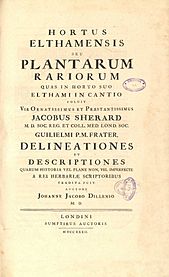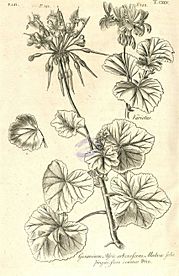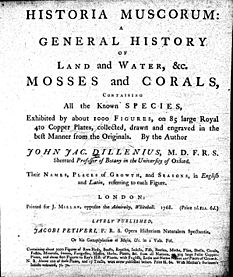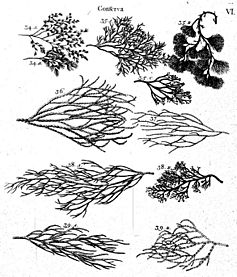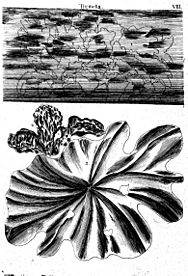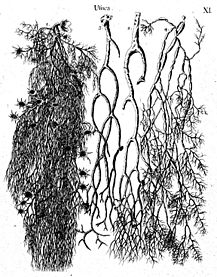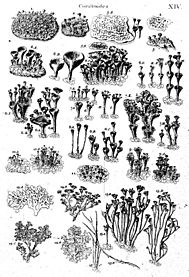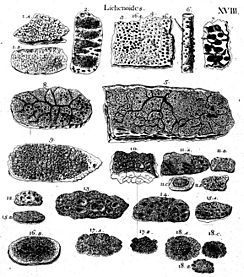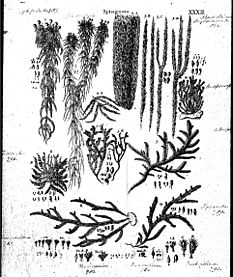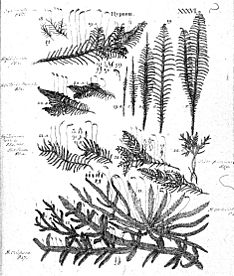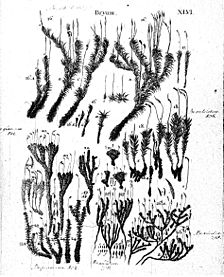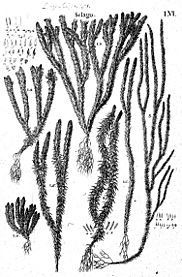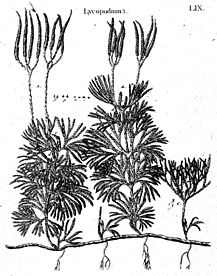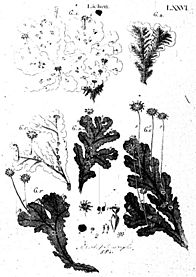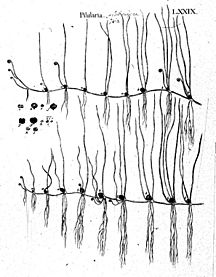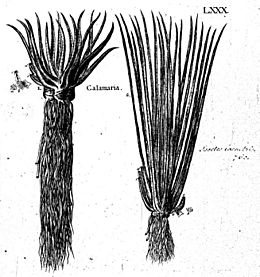Johann Jacob Dillenius facts for kids
Quick facts for kids
Johann Jacob Dillenius
|
|
|---|---|
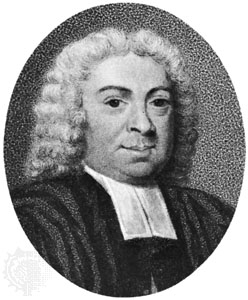 |
|
| Born | 1684 Darmstadt, Hesse-Darmstadt
|
| Died | 2 April 1747 |
| Nationality | German |
| Alma mater | University of Giessen |
| Known for | Hortus Elthamensis, Historia muscorum |
| Scientific career | |
| Fields | |
| Institutions | Oxford University |
| Influences | William Sherard |
| Influenced | Carl Linnaeus |
| Author abbrev. (botany) | Dill. |
Johann Jacob Dillenius (born 1684 – died 2 April 1747) was an important German botanist. He studied plants and is famous for two main books. One was called Hortus Elthamensis, which means "Eltham Garden". It was about unusual plants found near Eltham, London. His other famous book was Historia muscorum, or "History of Mosses". This book looked at many smaller plants like mosses, liverworts, hornworts, lycopods, algae, lichens, and fungi.
Contents
About Dillenius's Life
Johann Jacob Dillenius was born in Darmstadt, Germany. He studied at the University of Giessen. His family name was originally Dillen, but it was changed to Dillenius.
In 1721, a botanist named William Sherard invited Dillenius to move to England. Dillenius accepted and moved there.
Becoming a Professor
In 1734, Dillenius became a professor at Oxford University. This happened because William Sherard, who died in 1728, left money to the university. He also left his library and plant collections. Sherard's will said that Dillenius should be the first professor in this new role. This role was called the Sherardian Professor of Botany.
Dillenius passed away in Oxford from a sudden illness. His books, notes, and collections of dried plants were bought by the next professor, Dr. Humphry Sibthorp. Later, these valuable collections became part of Oxford University's history.
Dillenius's Important Work
While at Giessen, Dillenius wrote many papers about plants. In 1719, he published a book called Catalogus plantarum sponte circa Gissam nascentium. This book listed plants growing around the university. Dillenius drew and engraved the pictures himself. He also described several new plant species.
In 1724, Dillenius helped publish the third edition of a book by John Ray. This book was called Synopsis Methodica Stirpium Britannicarum. It included new plant species found by Samuel Brewer and work on mosses by Adam Buddle. This book was a key guide for British botanists for many years. It was used until Carl Linnaeus published his famous book Species Plantarum in 1761.
Hortus Elthamensis: The Eltham Garden Book
In 1732, Dillenius published his major work, Hortus Elthamensis. This large book, in two volumes, described about 400 plants. These plants were growing in the garden of James Sherard, William Sherard's younger brother. James Sherard was a very rich pharmacist who loved gardening and music.
Dillenius drew and engraved 324 plates for this book. These plates showed 417 different plant figures. The book called the plants "rare," but some were just uncommon.
Carl Linnaeus, another famous botanist, visited Dillenius in Oxford in 1736. Linnaeus spent a month with him. He later praised Hortus Elthamensis as one of the best botanical works ever. Linnaeus even named a group of tropical trees, Dillenia, in Dillenius's honor.
Historia muscorum: The History of Mosses
Dillenius also wrote Historia muscorum (published in 1741). This book was a natural history of smaller plants. It covered mosses, liverworts, hornworts, lycopods, algae, lichens, and fungi. He received help from George Charles Deering on this project. They had met at a botanists' club and studied fungi together.
- Sample of plates with original titles (and notes)
-
32 Sphagnum (bog moss)
-
76 Lichen (liverworts)
How Dillenius Was Honored
Johann Jacob Dillenius was highly respected in the world of botany.
In 1753, Carl Linnaeus named a group of flowering plants Dillenia in his honor. These plants are found in tropical areas of Asia, Australia, and islands in the Indian Ocean. The plant family they belong to is called Dilleniaceae.
Later, in 1997, a Spanish botanist named Gerardo Antonio Aymard Corredor also honored Dillenius. He named a group of flowering plants from South America Neodillenia after him. These plants also belong to the Dilleniaceae family.
Selected Publications
- Also on Gallica
- Facsimile edition 1973 , Ray Society, London. With introduction by William T. Stearn. ISBN: 978-0-903874-00-7
See also
 In Spanish: Johann Jacob Dillenius para niños
In Spanish: Johann Jacob Dillenius para niños


